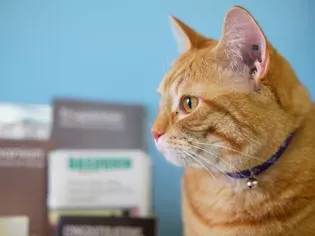Coronavirus in Cats
Updated on 05/26/24

Decoding the Coronavirus Conundrum: A Comprehensive Guide to Feline Health and Safety
As the world navigates the complexities of the COVID-19 pandemic, concerns extend beyond human health to our beloved furry companions. The emergence of a novel coronavirus in cats, officially known as Feline Infectious Peritonitis Virus (FIPV), has cast a spotlight on the vital need for understanding this potentially devastating feline health threat.
In this comprehensive guide, we delve into the intricacies of Coronavirus in Cats, empowering you with crucial information to safeguard the well-being of your feline friends. From transmission pathways to clinical signs, preventive measures to treatment options, this meticulously researched article equips you with the knowledge and tools to navigate this complex health landscape.
Understanding Coronavirus in Cats: A Brief Introduction
Coronaviruses are a diverse family of viruses that can infect a wide range of hosts, including humans, animals, and birds. In cats, two main types of coronaviruses are recognized:
* Feline Enteric Coronavirus (FECV): A common virus that causes mild gastrointestinal symptoms in most cats, similar to the human norovirus. FECV is usually self-limiting and rarely leads to severe complications.
* Feline Infectious Peritonitis Virus (FIPV): A more severe form of coronavirus that can cause a devastating inflammatory disease, affecting various organs in the cat's body, particularly the abdominal cavity and central nervous system.
Transmission Pathways: How Coronavirus Spreads Among Cats
Feline Coronavirus is primarily transmitted through direct contact with infected cats or their bodily fluids, such as feces, saliva, and nasal secretions. The virus can also be transmitted through contact with contaminated surfaces or objects.
Clinical Signs: Recognizing Symptoms of Coronavirus in Cats
Symptoms of Coronavirus in Cats vary depending on the type and severity of the infection.
Feline Enteric Coronavirus (FECV)
* Vomiting
* Diarrhea
* Lethargy
* Loss of appetite
Feline Infectious Peritonitis Virus (FIPV)
* Fluid accumulation in the abdomen (Ascites)
* Jaundice (Yellowing of the skin and mucous membranes)
* Weight loss
* Fever
* Lethargy
* Difficulty breathing
* Neurological signs (e.g., seizures, tremors)
Diagnosis: Confirming Coronavirus Infection in Cats
Diagnosing Coronavirus in Cats can be challenging due to the similarity of symptoms with other feline diseases. Confirmation typically involves a combination of:
* Physical examination: Your veterinarian will assess your cat's overall health and look for signs of fluid accumulation, jaundice, or neurological abnormalities.
* Blood tests: Bloodwork can reveal elevated inflammatory markers and changes in organ function, suggestive of FIPV infection.
* Viral testing: Polymerase chain reaction (PCR) tests can detect the presence of coronavirus in blood, feces, or other bodily fluids.
Treatment Options: Managing Coronavirus Infection in Cats
Treatment options for Coronavirus in Cats depend on the type and severity of the infection.
Feline Enteric Coronavirus (FECV)
* Supportive care: Fluids, electrolytes, and nutritional support may be necessary to manage symptoms.
Feline Infectious Peritonitis Virus (FIPV)
* Antiviral medications: Experimental antiviral drugs have shown promise in treating FIPV infection, but their efficacy is still being evaluated.
* Immunosuppressive therapy: This approach aims to suppress the cat's immune response, which can help reduce inflammation and organ damage.
* Palliative care: For advanced cases, palliative care focuses on managing symptoms and providing comfort to the cat.
Prevention: Protecting Your Cat from Coronavirus
Preventing Coronavirus infection in cats involves:
* Vaccination: While there is no specific vaccine for FIPV, vaccinating against FECV can help reduce the risk of exposure and development of FIPV.
* Isolation: Isolate infected cats to prevent transmission to other animals.
* Hygiene: Practice good hygiene, including frequent handwashing and disinfecting surfaces to reduce the spread of the virus.
* Stress reduction: Stress can compromise the immune system, making cats more susceptible to infection. Provide a stress-free environment for your cat.
* Regular veterinary check-ups: Regular veterinary check-ups allow for early detection and prompt management of any health concerns.
Conclusion: Empowering You with Knowledge and Prevention
Understanding Coronavirus in Cats is crucial for safeguarding the health of our feline companions. By recognizing the transmission pathways, clinical signs, and preventive measures, you can play an active role in protecting your furry friends from this potentially devastating disease.
Remember, seeking prompt veterinary attention is essential for proper diagnosis and treatment. Stay informed, take preventive actions, and provide your cat with the love and care it deserves.
Explore More Pets

Cat Behavior Problems
How to Stop Aggression in Kittens

Long-Haired Cat Breeds
Siberian Cat: Breed Profile, Characteristics, & Care

Cat Behavior Problems
How to Stop Kittens From Scratching and Biting

Long-Haired Cat Breeds
Turkish Angora: Cat Breed Profile, Characteristics & Care

Basic Training
How to Socialize Your Kitten

Short-Haired Cat Breeds
Cute Pictures & Facts About Calico Cats & Kittens

Litter Box Training
Training Your Kitten to Use the Litter Box

Long-Haired Cat Breeds
10 Fun Facts About White Cats
